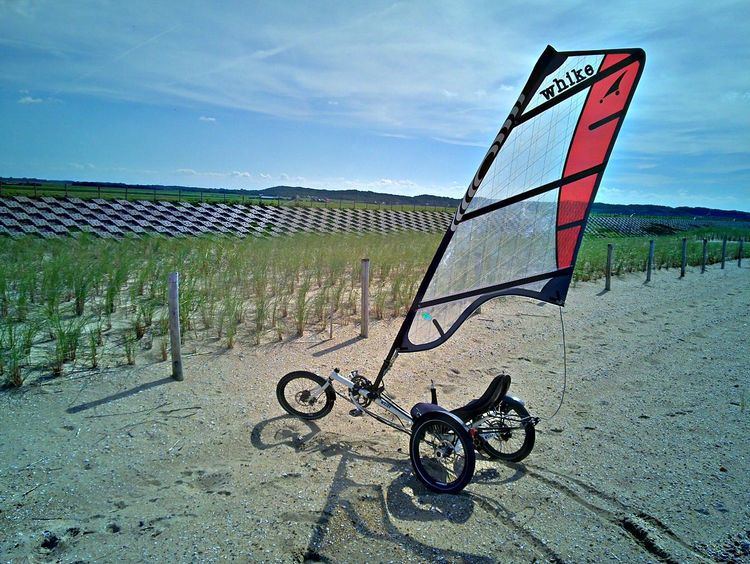 | ||
The Whike is a recumbent tricycle with a sail, made in the Netherlands.
Contents
The Whike 1.0 was released on 5 June 2008. It has a standard 1.6 m2 (17 sq ft) sail and can reach speeds up to 50 km/h (31 mph) with wind speeds of 4-5 bft (13–24 mph or 21–39 km/h). It can be legally used on both bike lanes and streets in the Netherlands and UK. Activating the front brake releases the sail's spinlock, assuring there will be no more wind-propulsion.
Features
The Whike features a three piece aluminium mast that can be stowed away on board when not needed. It is also equipped with 18 gears and the front sprockets are custom made for the Whike. To maintain safe and responsive stopping the trike is fitted with disk brakes on all wheels. The cycle also has a handbrake function to prevent it sailing away while without rider. The frame is available in black or white chromium molybdenum alloy steel, other colours are possible for an additional cost. The Whike weighs 23 kg (51 lb) including the sail and can carry a maximum weight of 115 kg (254 lb) including luggage. The sail also has the advantage of aiding visibility of the cycle on the roads.
Features list:
It is advised to ride a Whike only with a helmet, with a load of at least 65 kg (143 lb), to use a smaller sail at wind speeds over 5 bft (at more than 24 mph or 39 km/h) and not use any sail with wind speeds over 6 bft (at more than 30 mph or 48 km/h).
Availability
The Whike is sold directly to customers and is also available from some specialist suppliers. The Whike costs around €3500 for customers in the Netherlands (2010) with accessories available for additional cost. The Whike is also available for hire from several places. The Whike is now available in the UK and other European countries. Check their website for availability.
Accessories
A range of additional accessories to complement the cycle are available, Available Accessories include: A 1.0 m2 (11 sq ft) Storm Sail, a Headrest, lights and a Bike Computer. All of these accessories include factory fitting in the price.
A car carrier should also be available soon to allow the Whike to be easily transported.
Conception
The Whike was invented by Fredjan Twigt, a graduate of the Delft University of Technology. Twigt spent many years as an aid worker in Africa. After returning to the Netherlands he became addicted to recumbents. Besides recumbents he also has a passion for sailing. Because his ideal recumbent was nowhere to be found, he decided to build it himself. In 2007 he decided to combine his passions in the design that is the Whike of which many draft versions were made. The first prototype was big and heavy with relatively small wheels and sail. Now, after three prototypes, the design has been perfected. The result of all this work is the current Whike. Although other sail cycles have been made, this is the only one commercially available in Europe. There is however a commercial sail cycle system available in the US for around $5500.
Riding the Whike
The Whike is a tricycle with a sail, not a wind buggy with pedals. Its dimensions are meant for the road, and the sailing conditions are different from those on open water. You will need the pedals a lot, either to overcome built areas, or just because you want to go faster than the wind will make you go.
Buildings and trees have a huge impact on the wind and this makes sailing a Whike different from sailing a boat. In a boat, there is usually a lot of open space and the wind is not obstructed. A sailor on open water can determine the wind direction, set a course and position the sails accordingly. This usually does not work with the Whike, as it follows a road instead of a fixed course, and the wind is often influenced by buildings, trees and even passing trucks. Therefore, if there is enough wind, you will want to hold the sheet (the rope that controls the sail) in your hand, and keep the other hand on the handlebar and the rear brakes. This means that you can respond to all wind gusts and to wind-free wakes of large buildings. Keeping the sheet in your hand also gives you a feeling of how large the force of the wind is. You will notice that the driving force of the wind only needs to overcome the rolling friction to give you power. Catching a firm gust of wind can accelerate you fast.
In short, the rider does not set the position of the sail, but applies a certain amount of power to it.
The main things to avoid are Capsizing and low tunnels. The Whike is quite high for a bicycle, and some tunnels force the rider to get off and lift the front wheel to lower the mast. Because the Whike is a tricycle, the rider cannot tilt it in when making a turn, and in fact it will be slightly tilted outside by the centrifugal force. The centre of gravity of the Whike is quite low, but if the sail is locked, you take a turn fast, and wind blows to the outside of the turn, capsizing is not impossible. So especially in turns, keep the sheet in your hand and do not lock the sail.
